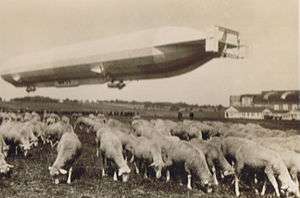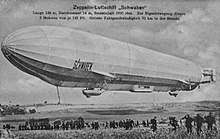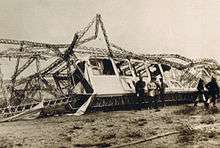LZ 10 Schwaben
LZ 10 Schwaben was a German rigid airship built by Luftschiffbau Zeppelin in 1911 and operated by DELAG (Deutsche Luftschiffahrts-Aktiengesellschaft) for passenger service. It is regarded as the first commercially successful passenger-carrying aircraft.
| Zeppelin LZ 10 Schwaben | |
|---|---|
 | |
| Role | Passenger airship |
| National origin | Germany |
| Manufacturer | Luftschiffbau Zeppelin |
| Designer | Ludwig Dürr |
| First flight | 26 June 1911 |
| Primary user | DELAG |
| Number built | 1 |
Design

The Schwaben was 140.21 m (460 ft) long, 14 metres (46 ft) in diameter and had a lifting gas volume of 17,800 m3 (628,000 cu ft). It was powered by three 108 kW (145 hp) Maybach engines, giving a maximum speed of 76 km/h (47 mph). Schwaben was the first Zeppelin to use these engines, which were used to drive most later examples. The cylindrical hull structure was braced by a triangular keel running most of its length, which was widened amidships to accommodate the passenger cabin, which had a capacity of 20 people. Two gondolas were suspended from the keel; the forward one containing the control position and one engine, and the aft one containing the remaining two engines. The engines drove two pairs of aluminium-bladed propellers mounted on brackets either side of the hull.[1][2][3]
Operating history

The LZ 10 made its first flight on June 26, 1911 and was put into service three weeks later, on July 16, 1911. It was called the "lucky airship" because it was more successful than any of the previous craft that DELAG had put into service, and was the first commercially successful passenger aircraft in history.[1] Over the course of the next year it made 218 flights, transporting 1,553 passengers.[4] among whom were Crown Prince Wilhelm and his wife. The Prince, who had a pilot's license, travelled in the control car, while the Princess and her attendants occupied the passenger cabin for a flight over Berlin.[5]
Schwaben was destroyed in a gale on June 28, 1912 at the airfield near Düsseldorf,[6][7] The wind prevented it being put into its shed, and it broke loose from its moorings and broke its back. The hydrogen was ignited by spark caused by static electricity accumulated in the rubberised cotton gasbags:[8] in moments the entire ship had been burnt. Sources differ regarding injuries suffered: the New York Times reported "34 soldiers were injured";[9] others claimed either 30[7] or 40 injured.[10]
Specifications
Data from Robinson 1973 p.330
General characteristics
- Crew: 13
- Capacity: 20
- Length: 140.21 m (460 ft 0 in)
- Diameter: 14.02 m (46 ft 0 in)
- Volume: 17,800 m3 (630,000 cu ft)
- Powerplant: 3 × Maybach C-X 6-cylinder inline piston engines , 108 kW (145 hp) each
Performance
- Maximum speed: 77 km/h (47 mph, 41 kn)
- Range: 1,400 km (900 mi, 780 nmi)
See also
- List of Zeppelins
- Post-Luftschiff Schwaben über Offenbach am Main 1912. Commons
Notes
- "The Zeppelin airship era" (PDF). www.zeppelin.de. Archived from the original (PDF) on 2011-07-19. Retrieved 2010-07-30.
- "A look at the Zeppelin LZ 10, the Schwaben". USA Today. 2009-10-29. Retrieved 2010-07-30.
- Botting, Douglas (2006). The Giant Airships. Time-Life Books. p. 42.
- Robinson, Douglas (1971). The Zeppelin in Combat (3rd ed.). Henley-on-Thames: Foulis. p. 15. ISBN 0 85429 130 X.
- "German Crown Prince in " Schwaben."". Flight: 1009. 18 November 1911.
- "Volume LXXXIII, Issue 154". The Evening Post (New Zealand). 29 June 1912. p. 7. Retrieved 31 July 2010.
A squall at Dusseldorf wrecked an anchored airship. ... injured several people
- "German Aviation". The Straits Times. 29 June 1912. p. 9. Retrieved 31 July 2010.
thirty people were injured
- Robinson 1973, p.61
- "WILL NOT RETARD AVIATION.; American Experts Attribute Accident to Stress of Competition" (PDF). New York Times. 1913-10-18. Retrieved 2010-08-02.
thirty-four soldiers were injured ... She was at anchor before her shed when a gust of wind tore her from her moorings.
- postcard image courtesy of Jean-Pierre Lauwers with caption: "28 Jun 1912, LZ 10 Schwaben met a fiery end on Golzheimer heide near Düsseldorf. ... forty persons were wounded. ... Eight passengers and crewmen, including Dürr were seriously injured ... soldiers ... suffered flash burns."
References
- Robinson, Douglas H., Giants in the Sky Henley-on Thames: Foulis, 1973 ISBN 0-85429-145-8
- Dirk Hecht, Zeppeline über Schriesheim. In: Schriesheimer Jahrbuch 2011, 2011, 99–111 (with pictures);
Further reading
![]()
- Evening Post – 9 November 1912 – Page 10, newspaper article with statistics on the Schwaben